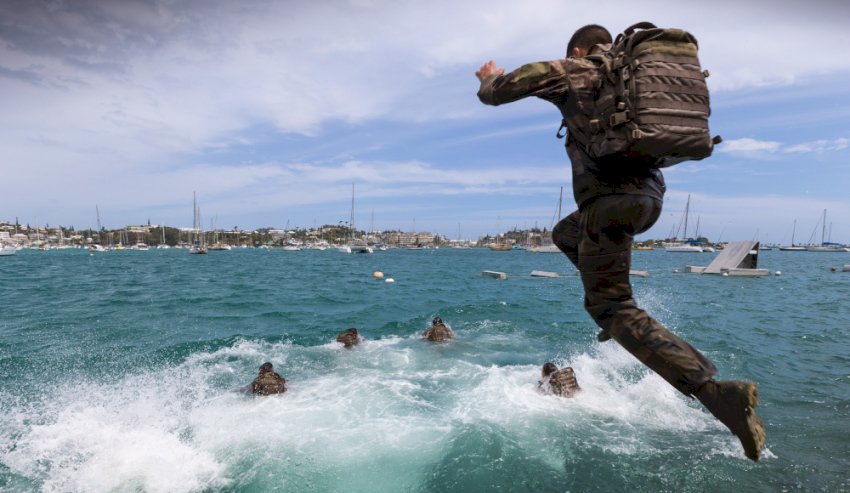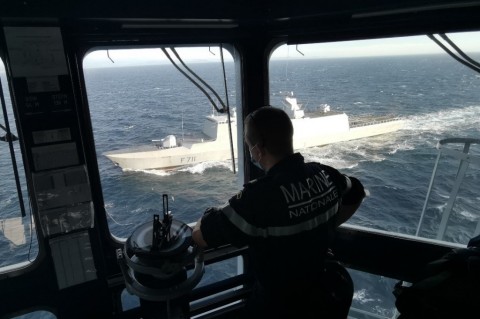By Murielle Delaporte – This is a long version of an article published in the US publication Breaking Defense on March 11th, 2021.
‘’Initiated and adopted by several nations in the past years, the concept of an Indo-Pacific theater does not mean the same for each one of them. For France, which is the very first European nation to have replaced the traditional Asia-Pacific concept with a more assertive Indo-Pacific strategy, the key is the inclusion of India in the equation – as well as our territories in the Indian Ocean which legitimizes such a posture -. The reason is tied to New Delhi’s political dimension which is crucial to counter-balance Beijing’s growing weight in this part of the world’’, explains a French submarine officer familiar with this region.
Balance is indeed the leit motiv in the current Macron government’s approach to foreign affairs. Fearing an escalation fueled by increasing military expenditures and growing tensions while dreading a replay of the Cold War – this time between the United States and China -, France is once again positionning itself as a ‘’stabilizing power’’ in a zone which ‘’spans from Djibouti to Polynesia’’, as stressed in the 2019 ‘’French Defence Strategy In the Indo-Pacific’’ official document. The latter followed President Macron’s Garden Island speech, a speech he made a year earlier during his official visit to India. The 2018 statement highlighted the concept of a ‘’Paris-Dehli- Canberra axis’’, which his minister of foreign affairs, Jean-Yves Le Drian had already promoted in 2016 when minister of defense under the form of ‘France-India-Australia trilateral framework.
Sharing the exact same diagnostic as Washington (both under President Trump and President Biden) as far as the serious nature of Chinese aggressive action is concerned, the French government has not been shy in condemning Beijing on multiple grounds, ranging from the Uyghurs’ genocide to the Belt and Road Initiative.
Regarding the Indopacific region, the concerns expressed by French officials are indeed specifically related to Beijing’s ability to systematically ‘’fill the vacuum’’ whenever an opportunity emerges and deny access to other players. The ways and means to progressively evict other nations’ influence are limitless and include in particular:
- The polarization and militarization of international waters with the unilateral extension of territorial waters from 12 to 15 nautical miles (e.g. Paracel Islands in 2017 in the South China Sea): according to a 2016 DoD estimate, 3,200 acres of land have been artificially created at the time.
- Investments in key strategic infrastructure via China’s One Belt One Road Initiative : the deep-water port of Kyaukpyu in Myanmar, the development of the Hambantota port in Sri Lanka or the operational control of the Gwadar port in Pakistan by the China Overseas Port Holding Company are all part of the Twenty-First Century Maritime Silk Road under way since 2013 designed to enhance connectivity throughout Southeast Asia, Oceania, the Indian Ocean, and East Africa.
- A growing military presence officially aimed at protecting Chinese communities abroad : the most telling example of such a strategic shift in Chinese military doctrine is the case of Djibouti. Beijing’s footprint – and foothold in the Western Indian Ocean – has been growing since 2008 through various investments in salt, railway, and the port of Doraleh. Its naval military presence has evolved from anti-piracy operations to the inauguration in 2017 of its very first overseas naval base, which currently hosts an estimated 2,000 troops but has a capacity of 10,000. In ten years – from 2008 to 2018 -, China’s 350-ship Navy trained about 100 ships and 26,000 sailors in the Gulf of Aden alone…
Such a trend privileging the policy of ‘’fait accompli’’ has been enhanced by the Covid crisis, during which China has been multiplying its military manoeuvers in the straights of Taiwan, Miyako and Bashi, while the very first deadly border clash with India in 45 years occurred last June in the Himalaya.
‘’In a region including seven out of ten of the highest defence budgets in the world (the Unites States, China, Saudi Arabia, India, France, Japan and South Korea), strategic and military imbalances constitute an underlying danger with global consequences. While several open crises persist and new rivalries emerge, the breakdown of strategic stability, or a lasting deterioration in the regional security environment, would have an immediate impact on France’s political, economic, and sovereign interests’’, states the above-mentioned 2019 French Defence Strategy In the Indo-Pacific official document.
Having appointed last November and for the first time an Ambassador for the Indopacific, France is indeed a riparian and sovereign Indopacific nation with clear vested interests starting with the protection of some 1.6 millions French citizens leaving in its seven overseas regions, departments and communities (called DROM-COM in French for ‘’Départements ou Régions français d’Outre-Mer’’ and ‘’Collectivités d’Outre-Mer’’). In the Indian Ocean are Mayotte, Reunion, the French Southern and Antarctic territories (Kerguelen, Amsterdam and Saint-Paul islands, and the Crozet islands). In the Pacific are New Caledonia, Wallis & Futuna, and French Polynesia. In addition, 200.000 French citizens settled in the littoral countries of the Indian Ocean, in Asia and Oceania. Far away and tiny for some of them, these territories nevertheless represent all together 93% of France’s Exclusive Economic Zone (EEZ) (9 out of 11 million square kilometers), making it the second in the world after the United States.
Stability, with the defense of Sea Lines of Communication (SLOC), and, more generally, of the Global Commons at a time when military competition knows no boundary and opens new ones ranging from seabeds to exoatmospheric altitudes, is indeed a main concern shared not only by Paris and Washington, but also and foremost by the regional players in the Indopacific.
How to reduce threats in order to enhance stability and promote the ‘’new Golden age’’ many experts foresee in that part of the world is however where differences of approach coexist.
Forging Alliances Among Like-Minded States
The French strategy in the Indopacific region lies on three axis: developing joint crisis management tools, enhancing bilateral relations and fomenting a rule-based multilateral framework. Reviving multilateralism in an inclusive manner as a way to contain a potential ‘’Great Power Competition’’ clash or growing tensions is where France and the United States has till now differed since Washington’s position under President Trump was aiming more towards a policy of isolation against China.
This difference of approach has been highlighted in diplomatic terms, but tends also to translate in the military posture of both countries in the region (all proportion kept of course): ‘’the French Navy will show its willingness to defend the freedom of navigation in this part of the world, for instance in the strait of Taiwan where it sails on a regular basis, but faced in 2019, and for the first time, unusual protestation from the Chinese against the manoeuver of our French Frigate – the Vendémiaire –. However, when the U.S. Navy will choose to deploy an aircraft carrier, the French Navy will be using a frigate or an amphibious assault helicopter carrier (PHA in French for ‘’porte-hélicoptères amphibie’’) and choosing to sail a straight course rather than demonstrating a more assertive posture”, notes the French Commander.
Having concluded a global strategic partnership with China along with the ones negotiated with India and Australia, France advocates less a policy of containment than a policy of coercion which does not preclude commercial ties.
A form of ‘’Realpolitik’’ or ‘’Pacific coexistence’’ which resonates with many of the states leaving in the region which economies are heavily dependent on good relations with China.
Clearly the more ‘’like-minded’’ states the better to counter Chinese illegal endeavours in the region. Paris favors a regional multilateralism considered ideal to promote ad hoc structures best suited to address the challenges in this part of the world whether humanitarian, health-related, digital, environmental or else. Last September, was held for instance the first trilateral meeting between France, India and Australia with the participation of the General secretary of the minister of foreign affairs. The goal is to include Japan next, while more multilateral coordination to act jointly is aimed for. Hence Paris’ recent request accepted last September to become a partner to the existing ASEAN (Association of Southeast Asian Nations), a multilateral framework created in 1967 (two years after France’s withdrawal from the Southeast Asia Treaty Organization or SEATO – i.e. the equivalent of NATO in Asia – because of disagreements between France and the United States over Vietnam).
In addition, Paris has been developing strong bilateral relationships over the years – in particular with India, Australia (both countries with which Paris has concluded global strategic partnerships) and more recently with Japan – as well as various fora of discussion ranging from commercial and technological exchanges, climate change and natural disaster anticipation, to the fight against transnational threats (illegal traffics, criminality, jihadism, etc.).
France is for instance – in chronological order and in a non-exhaustive way – a member of the Western Pacific Naval Symposium since 1988, concluded the FRANZ agreement with New Zealand and Australia for disaster relief in 1992, the Indian Ocean Rim Association (IORA) established in 1997, as well as the Quadrilateral Defence Coordination Groupe with the United States, Australia and New Zealand since 1998. France is also a founding member of the Indian Ocean Naval Symposium (IONS) established in 2008, belongs to the South Pacific Defence Ministers mechanism since 2013, as well as the Pacific Islands Forum with the participation of both New Caledonia and French Polynesia since 2016.
Because France has been itself a medium-sized Pacific power for more than two centuries, it feels directly threatened by the growing instability impacting its territories and communities, some of them risking to vanish because of climate change and consequent water rising.
Strengthening strategic autonomy is also a shared concern, hence the well-known Rafale deal with India and submarine ‘’deal of the century’’ with Australia. But military ties between France and its main allies in the Pacific go increasingly way beyond industrial partnerships towards more comprehensive operational relations between not only “like-minded” states, but also comparable military formats.
Photo © A French Armed Forces New Caledonian soldier leaps in after Australian Army soldiers from the 2nd Battalion, Royal Australian Regiment to complete a water based obstacle course during Exercise Croix du Sud 2016. Image via Commonwealth of Australia, Department of Defence, as published in >>> https://www.defenceconnect.com.au/key-enablers/2298-exercise-croix-du-sud-kicks-into-gear












